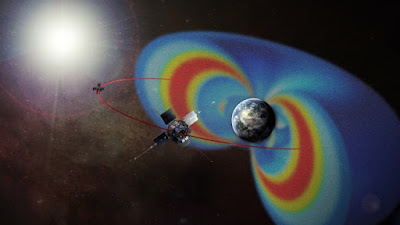Further Protection from our Deflector Shields
If you did not read the news, space is a dangerous place. Aside from the lack of air, it is full of large and small objects zipping around (sometimes falling to Earth and scaring the horses). This includes high levels of radiation from our friend the sun. That friend would fry us deader than a — never mind. But the Master Engineer who gave us our usually well-mannered sun also gave us protection from it.
There have been a couple of posts here about the Van Allen belts, our planet-sized deflector shields that protect us from the solar output and the sun's occasional sneezes. The solar wind is pretty much constant, and Earth plows through it like a boat through water. This bow shock does some interesting things to the electrons that should join in with the other solar stuff to destroy us. Instead, friction from those bad boy belts shred the solar wind. Some owlhoots will have us believe this is the product of luck and cosmic evolution. Not hardly!
 |
| Twin Van Allen Probes image credit: NASA (Usage does not imply endorsement of site contents) |
To read the rest of this fascinating article, click on "Van Allen Belts Protect Earth from Solar Wind".Geophysicists are still puzzling over how the earth’s magnetic field and Van Allen radiation belts protect the surface from deadly particles in the solar wind.The Van Allen belts are lobes of high-energy particles above the atmosphere, formed as a consequence of the geomagnetic field. First discovered in 1958 by Dr James Van Allen of the University of Iowa, using instruments aboard the Explorer satellites designed by JPL spacecraft pioneer Dr. Henry Richter, these belts have long puzzled scientists. A pair of spacecraft called the Van Allen Probes have been gathering data about the belts since 2012. NASA’s Magnetospheric Multiscale Mission (MMS) also gathered data since 2015. Elizabeth Howell provides this overview of the Van Allen Belts on Space.com. She says,